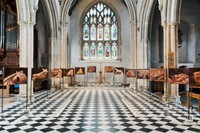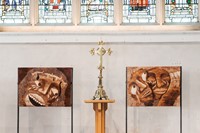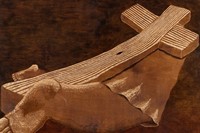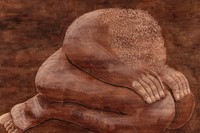Curated by Ben Broome, Orfeo T’s new exhibition reimagines the stations of the cross for a contemporary audience. “This is one of the most tragic, potent, heartbreaking narratives,” he says
For those who have grown up within the Christian faith, the stations of the cross are an instantly recognisable set of images. These small, violent renderings are hung together within churches to depict the 14 stages on Jesus’ arduous walk to crucifixion. Now, Orfeo T has reimagined the stations for a contemporary audience in his new exhibition The Stations of the Cross, with the final etched and stained birch ply works hanging in London’s St Giles Cripplegate Church in the Barbican.
The artist’s early experience of Catholicism was as an outsider. After moving to the UK from Cambridge, Massachusetts, he attended a local school that required his non-religious family to join a church. He also recalls attending a Christian Saturday school with friends in London, where he was the only child unable to participate in communion. “It’s strange to think of being with the intensity of those narratives and at the same time being loosely aware that I was cheekily subverting that system,” he says. “I think it must have been quite a confusing sense of up and down, right and wrong, my child’s law versus some greater spiritual law.”
Orfeo’s images are raw and emotional. A tight crop of Jesus’ face flooded with large teardrops conveys the physical terror of crucifixion. Another image, in which Jesus is stripped of his garments, shows the vulnerability and fragility of his naked body curled over protectively. The positioning of the figures in the works, as well close-ups of a giant hand holding the cross and two large, foregrounded feet with nail puncture wounds, places the viewer into the action, as though they are taking part rather than watching from a safe distance.
“I have seen a lot of stations of the cross images,” says the artist. “They are often quite didactic, rather than being visceral or emotionally evocative. This is one of the most tragic, potent, heartbreaking narratives, even if one chooses to take it as a work of fiction, and I was struck by the fact that many of the works didn’t tug on my heartstrings in the same way the story objectively does.”
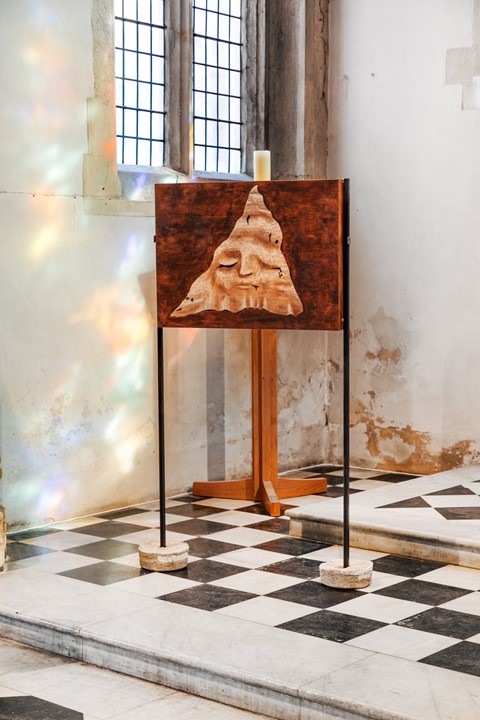
Orfeo is also interested in the symbolism of the stations of the cross, which can be viewed as an analogy for the experience of growing up. “There is a Jungian take on it,” he says. “Going through your life, you have these moments where identity deaths occur and allow you to grow into something else. Maybe you picked a goal for yourself and then you realise that’s not what you really want. Or you’re in a relationship and you realise it’s not the direction you need to be heading in. There are these moments of personal growth that require a passing of yourself from one form into a new form.”
It was important for the artist to bring these works into a religious building for the exhibition. While the intention of churches may be very different from contemporary galleries, he sees parallels in the feelings evoked and the reverence often granted to both spaces, with lowered voices or silent contemplation. “As someone who has always enjoyed entering a church, I was curious about creating something that engaged in that space while creating an avenue for people who have been othered or persecuted by the messaging and behaviours of the church,” he says.
The exhibition’s curator, Ben Broome of Drawing A Blank, acknowledges the challenge of curating for a church, and says his own work was also driven by a desire to create something accessible. “I’m not religious and initially I was unsure of how to approach the church curatorially, a space that feels inaccessible for so many. On reflection this is also true of institutional art spaces,” he reflects. ”I think what Orfeo does so well with these works and the corresponding space in which they’re shown is to bring churchgoers into a conversation about contemporary art with artworks that they feel a kinship with. Similarly, the works bring a contemporary art audience into a religious space.”

While the stations of the cross could be seen as incredibly traditional source material, the artist finds significance in the story for a contemporary audience, at a time when many people are searching for meaning. “We’re at a moment when people are redefining our relationship to spirituality,” he says. “We are really deciding what we want to carry forth from these traditions.”
The Stations Of The Cross by Orfeo T is on show at St Giles Cripplegate Church in London until October 25.

